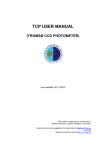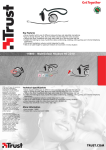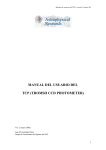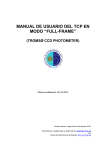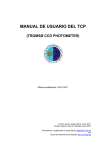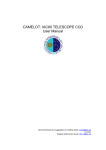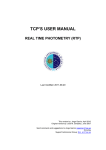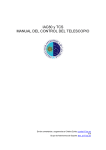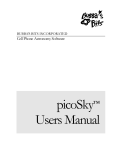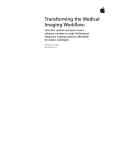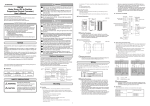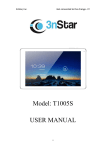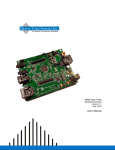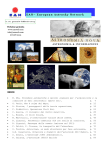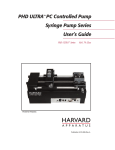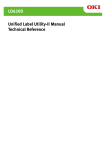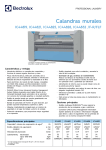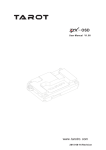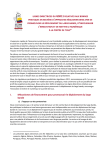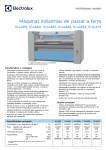Download TCP USER MANUAL “FULL
Transcript
TCP USER MANUAL “FULL-FRAME MODE” (TROMSØ CCD PHOTOMETER) Last modified: 09-10-2012 This version: Jorge García, November 2012 Send comments and suggestions to Jorge García: jogarcia AT iac.es Or to The IAC Support Astronomers Group: ttnn_a AT iac.es TCP user manual 15/11/2012 INDEX 1. INTRODUCTION ........................................................................................................ 3 2. STARTING A SESSION ............................................................................................. 4 3. INFORMATION ABOUT THE OBJECT ................................................................... 8 4. GETTING THE IMAGES.......................................................................................... 10 4.1. Full frame ............................................................................................................ 10 4.1.1. Ideal display mode........................................................................................ 11 4.1.2. Example 1: flat field in B filter, 5 seconds exposure time ........................... 12 4.1.3. Example 2: bias ............................................................................................ 13 4.1.4. Example 3: Astronomical objects................................................................. 13 4.2. Taking BIAS, FLATS and DARKS .................................................................... 14 4.3. Focusing............................................................................................................... 14 4.4. Observation sequence with a single filter............................................................ 15 4.5. Observing in multicolour mode........................................................................... 16 4.5.1. Multicolour mode: common exposure time.................................................. 16 4.5.2. Multicolour mode: different exposure times for each filter ......................... 17 APPENDIX I: Additional notes ..................................................................................... 20 APPENDIX II: Common problems................................................................................ 21 APPENDIX III: Pixel size and detector orientation....................................................... 23 2 TCP user manual 15/11/2012 1. INTRODUCTION The Tromsø CCD Photometer (TCP) is a portable instrument optimized for fast reading photometry (Windowed system) based on CCD technology. The TCP incorporates the possibility of an on-line data reduction, i.e. the real time production of light curves and the calculation of the Fourier transforms of the data obtained so far. This instrument was built by the Physics Department at the University of Tromsø (Norway) –see Roy Ostensen's doctoral thesis at http://whitedwarf.org/theses/ostensen.pdf – in collaboration with CUO (Copenhagen University Observatory). The TCP, installed on the IAC80 telescope since 2002, is one of the telescope’s common user instruments. This document is intended as a detailed guide for using the user interface for data acquisition of TCP. Figure 1. TCP. The TCP electronics driver was developed by CUO. The current version of TCP uses the CCD chip Site (Tektronik) 1024 x 1024, which operates at a temperature of -40 º C below the ambient temperature. The pixel size is 24 x 24 microns. The chip covers an area of 2.56 by 2.56 cm, which is a square field of about 9.2 arc minutes side in the IAC80. It is a back-illuminated chip with a high sensitivity in both the red and blue ranges thanks to its special coating. The TCP includes its own filter wheel and shutter (FASU). The FASU was designed with a unidirectional shutter to increase the accuracy of the exposures and a filter wheel that allows installation of up to 6 filters of 50 mm diameter. Currently available are the Johnson-Bessell filters U, B, V, R, I and an open position (white light). Switching between filters takes about 0.5 s, allowing the implementation of multiband photometry programs almost simultaneously. 3 TCP user manual 15/11/2012 2. STARTING A SESSION The following paragraphs describe the follow-up sequence to properly booting and checking out of the system. ► In the dome, check that the Electronic Racks of TCP are turned on (see Figure 2). Figure 2. Location of the switches of the TCP Electronic Racks. ► The TCP computer is located above the FOVIA-II monitor (see Figure 3). It is normally turned on. If not, turn it on. The computer must be connected to the network. If there are problems with the network, consult the start-up procedure of the TCP computer in Appendix II (Problem 1). The TCP computer is not used directly, but through asteroide PC. When you finish the process of booting the computer you will have to wait a few minutes to connect from asteroide. Figure 3. TCP computer (red) and asteroide computer (blue). 4 TCP user manual 15/11/2012 ► Start a session in asteroide: connect as “obstcs1” (password: ask the support astronomer or the night assistant). ► Open a terminal in asteroide and type: >ssh –l observer tcp.ll.iac.es assistant.). (pass: ask the support astronomer or night ► Once in tcp, open a new terminal: >xterm & ► In the new terminal, type: >download gpsold.hex This command will initialise the camera. When executing, the camera will start the process with: ‘download code to the camera *******’. If there are camera connexion errors, please contact the support astronomer (Appendix II – problem 2). ► Running the data acquisition software: >Qtcp15 ► The display will show the graphical interface of the data acquisition program (see Fig. 4). The user must check the messages appearing at the bottom-left line (marked in red) during initialization: "Shutter initialisation" and "FASU initialisation”. If all goes well, after 2 or 3 seconds, the message "working" or "idle" should be displayed. If the system is having problems initializing the shutter and/or FASU, a message notification will be displayed. In this case you need to contact the Support Astronomer to restart the system (Appendix II - Problem 3). Figure 4. Graphical interface of the TCP data acquisition program. 5 TCP user manual 15/11/2012 In Figure 4 we can see that only a part of the area of the chip is displayed. There are vertical and horizontal scrollbars to move through the chip. On the other hand, the overall size of the user interface can be changed by pressing the left mouse button in the lower-right corner and, while holding down, dragging it. When Qtcp15 program starts, it automatically creates a directory in home/observer, whose name is the combination of the starting date and time of the program (e.g. 2103042005 -21 March 2004 at 20:05 - ). Within this directory, Qtcp15 creates a series of sub-directories where the program automatically save the different image types taken: bias, flats, darks, tcp (for full-chip images) and data (for images in windowed mode). ► Check that the system is receiving data from the GPS. To do this, press the satellite button in the top right corner of the user interface (see Figure 5). Figure 5. GPS Information. It is imperative that the system receives information from the GPS to work properly. If all goes well, the following information box is showed: Figure 6. Info panelof the GPS. In this case the GPS is receiving the signal of 4 satellites. In case the GPS does not receive any signal, contact the support astronomer (see Appendix II, problem 4). ► Establish location. Thus, the information about the observatory, telescope and instrument will be saved in the image headers. 6 TCP user manual 15/11/2012 a) Press ‘File’ in the main menu and select ‘localisation’ (see Figure 7, left). In this option, a box with the available observatories and telescopes will be shown (see Figure 7, right). b) Select the telescope (IAC80). (1) In the ‘Observatory’ dialog box, select ‘Teide observatory’ (at the end of the list). (2) In the ‘Telescope’ dialog box, select ‘IAC80’. Information about longitude, latitude and height of the observatory and also about the focal relation of the telescope will be shown. (3) Press ‘apply’. Figure 7. Selection of the information (telescope, observatory, instrument) that will be saved in the image headers. 7 TCP user manual 15/11/2012 3. INFORMATION ABOUT THE OBJECT To enter the information about the object you want to observe, there are several steps to follow. ► Press the option ‘File – Targets’ in the main menu and select the file ‘Targets.lst’ or similar in the main directory. Figure 8. Selection of the file for reading and/or saving information about the objects to observe. If the object is not in the list, it can be added by typing the information in the corresponding dialog boxes of the program utilities bar: Field 1 for the Object Name, Field 2 for the Right Ascension and field 3 for Declination. Figure 9. Information Fields of the object. ► Once the information has been written it is useful to add it to the list of objects for future observations. Press button or add it from the main menu by selecting: ‘File – Add to list’. ► Select an object from the list. The object information will appear in the fields 1, 2 and 3. Click on the button or go to: ‘File – Get from list’ in the main menu. A new window will be opened with the objects included in the file (see Figure 10). To proceed with the selection, double click in the object you want to observe. 8 TCP user manual 15/11/2012 Figure 10. Selection of the object. The user interface will also show the air mass (4) and the sidereal time (5). Please, press tab key just after filling each field; otherwise the information will be lost and will not be saved in the headers. 4 5 Figure 11. Information about the selected object. Field 4 shows the air mass and Field 5 the sidereal time. These data will be saved in the image headers. 9 TCP user manual 15/11/2012 4. GETTING THE IMAGES 4.1. Full frame The full frame images will be saved in the subdirectories 'tcp' (for objects), 'darks', 'flats' or 'bias', depending on the selected image type. The steps to be carried out are listed below. 1 ► Check that ‘single shot’ option in area 1 (‘Exposure’) is selected. ► Select the exposure time by typing it directly or using the arrows. 2 ► Select the filter in area 2 (‘Filter’). 3 4 ► Check that the ‘Full frame’ option is selected in area 3 (‘Transfer mode’). ► In this area, select the type of image to be taken: Flat field, Dark, Bias or Object. The images will be saved in the subdirectories flats, dark, bias o tcp depending on this selection. ► Take the image by pressing ‘START’ button in area 1. Figure 12. Full frame image sequence. If the program does not respond when you try to change the filter, contact the Support Astronomer (Appendix II - Problem 3). After each exposure some image information is displayed by pressing the left mouse button over the image: relative position of the cursor, number of counts and distance to the centre of the field in arc seconds. This information appears in the bottom part of the user interface (see Figure 13). 10 TCP user manual 15/11/2012 Figure 13. Information obtained by clicking the left mouse button over the image: location, number of counts and position in arc seconds In the following pages we show the different display options and some image examples –flat fields, bias and object–. 4.1.1. Ideal display mode. The default image display option is ‘min-max’, but it might be inadequate. To change the display mode press the button in the utilities menu bar. Then, the following panel is shown: Figure 14. Display mode selection panel. Selecting "Histogram Equalization" you increase the relative contrast in all the regions of the chip. Once this type of image display is chosen it will be set as default. Important note: This display mode greatly increases the display contrast and sets the grey scale zero level very close to the average bias value, with the idea of showing any pixel with some energy over this value. The images shown in this way may give the impression of a defective chip or that the optics is dirty, but it is in its main part due to the visualization algorithm. On the other side, this visualization m ode significantly increae the overheads, owing to the high RAM m em ory required for displaying the im ages. Therefore, it is not recom m ended for the “full fram e” m ode. W e recom m end to use IRAF to check the im ages . 11 TCP user manual 15/11/2012 4.1.2. Example 1: flat field in B filter, 5 seconds exposure time Figure 15. Example of full frame image: filter B flat field with 5 seconds exposure time. The display mode is 'min-max'. Figure 16. Same image than Figure 15 but using the 'Histogram-Equalization' display mode. 12 TCP user manual 15/11/2012 4.1.3. Example 2: bias Figure 17. Example of full frame image: bias. 4.1.4. Example 3: Astronomical objects Figure 18. Central star of the planetary nebula NGC246 using B filter and 30 s of exposure time. This image shows objects until 12 magnitude. The image looks somewhat dirty due to the use of the 'Histogram-Equalization' display mode. 13 TCP user manual 15/11/2012 4.2. Taking BIAS, FLATS and DARKS ► BIAS: it is recommended to take 5-10 BIAS. The number of counts should be less than ~2,300 counts/pix. If this is not the case probably the cooler (peltier) is not working appropriately. In that case, please call the Support Astronomer. ► FLATS: the average number of counts should be between ~18,000 and ~21,000 counts/pix to be sure that they are in the linearity range of the detector. If good photometric precision is required, it is recommended to take enough number of flats so that the total sum of counts exceeds ~ 100,000 (about 5 if the average is 20,000 in each image). Combining about 100,000 counts would roughly give a s/n ratio ~ 100, which would become the photometric limit. If you take dome flats, there is a table in the control room showing the exposure times and the lights used to get images with an adequate level of counts with different filters. ► DARKS: Dark current can be mportant in relatively short exposure times images in this CCD. We recommend to take dark exposures for exposures longer than 300 sec. 4.3. Focusing ► Important: The TCP focus position is different to the CAMELOT one. In the first night some time should be spent in finding the TCP focus. As a starting point, read in the logbook the last TCP focus used. The focus value for FOVIA-II is also different. Some values (used in March 2010) are: Telescope focus ~ 21,760 (Filter R); FOVIA-II focus ~ 12, T1 = 7.3. In general, the TCP focus is 2,000 units larger than the CAMELOT focus. ► To focus the TCP not very bright objects (V<9) must be taken. Select "object" in the Exposure mode (area 4) of the selection window (see Figure 12), V filter, and an appropriate exposure time for the magnitude of the given object: the maximum amount of counts of the star used to focus should not exceed 23,000 counts. ► Image analysis will be done from asteroide using IRAF: (1) enter as "obstcs1", (2) open a "xgterm", (3) run IRAF "ecl" and "ds9", (4) access to the images directory on TCP. The disc is automatically mounted when connected to the tcp computer. Once mounted, you can access with >cd /tcp. (5) Review the focus of the standard way: using imexam and making the star contours as circular as possible. If the image in QTCP15 (in IRAF you have to reverse “y” axis) appears: ⇒ decrease focus ⇒ increase focus ► Once the best focus is selected please annotate in the logbook the values of the telescope and FOVIA-II foci and the temperature of the mirrors. 14 TCP user manual 15/11/2012 4.4. Observation sequence with a single filter TCP allows the observer to make sequences of images. Depending on whether you are going to use a single filter or several filters (multicolour mode) the technique varies slightly. This section will describe what to do to make a sequence of observations using a single filter (for example, for bias and/or flats) ► Select the exposure time and select Sequence in the corresponding area (‘Exposure’) in the left side of the user interface. ► Select the Sequence time in the corresponding area (‘Sequence’) in the left side of the user interface. Figure 19. Selecting the sequence time. NOTE. Sequence time = exposure time + readout time (~23 sec for “full-frame”) + additional delays due to filter changes and/or shutter movements. In “full-frame” mode we recommend to add 30-35 additional seconds. ► Write 9999 (or 0) in the 'Frames' field of the 'Sequence' area. Thus, the program will take data continuously until the sequence is aborted. Imagen 20. Selection of frame number. ► Check that the selected filter is the one requested. ► Start observations by clicking the button 'START' (area 1 in Figure 10). The first image will begin in the closest multiple to the selected sequence time. For example, if the sampling time is 20 s and the 'START' button is pressed at 21:30:04, the exposure time of the first image will start at 21:30:20. IF THE SEQUENCE TIME IS TOO MUCH LARGER THIS OPERATION CAN TAKE A LOT OF TIME!!! 15 TCP user manual 15/11/2012 ► To stop the sequence press ‘ABORT’ button, placed where the 'START' button was before. 4.5. Observing in multicolour mode The TCP offers the possibility of observation sequences using a single filter (default) or multicolour mode. For this reason, there is a button on the left side of the user interface that activates or deactivates the multicolour mode (multifilter). There are two different procedures to access this option, as the user could want to use the same exposure time for all the filters or to assign a different exposure time for each of them. In general, the steps to observe in multicolour mode are: ► Bias and flats are taken as explained in Section 4.2. Of course, as many flats series as filters to be used must be taken. The process for taking full frame images is also performed as described in Section 4.1. 4.5.1. Multicolour mode: common exposure time This is the simplest procedure. Proceed similarly as was described in Section 4.4 but, before starting the sequence, the following steps must be added: ► Press the button that activates the filter selection (see Figure 21). ► This opens an information box (see Figure 22 below). Select the filter sequence to be used (sorted). To do this, click on each selected filter (green arrow). NOTE: In this mode, SET THE EXPOSURE TIME TO ZERO FOR ALL FILTERS (boxes to the right of each button). ► Enable the “multicolour” mode (see Figure 23). ► In the filter option, set the first filter of the cycle, e.g. select “B” (number 2), for a BVI sequence. ► In the exposure field, set the exposure time ► In the sequence field, set the sequence time (exposure time+overheads) and the number of frames. ► Start the sequence by pressing the ‘START’ button. Figure 21. Setup button of the multicolour mode. 16 TCP user manual 15/11/2012 Figure 22. Filter and exposure time selection. The sequence is set by pressing, in order, the filter buttons (green arrow). The exposure time for each filter is set in the right field (red mark), using the arrows. The sequence is indicated in the upper field. Figure 23. Button enabling the multicolour mode. 4.5.2. Multicolour mode: different exposure times for each filter This observation mode is more versatile, but the procedure involves additional steps. The following describes how to proceed: 1 Press the button to activate the filter selection (see Figure 21). 2 This action opens an information box (see Figure 22). Select (sorted) the sequence of filters to be used and the exposure time for each (see Figure 22). To do this, click on each of the selected filters and use the arrows on the fields located to the right of the filter selection buttons to set the exposure time. The sequence will be displayed on the upper field of the window. The example of Figure 22 shows the following sequence: 5 s. image in B filter, 8 s. image in V filter and 4 s. image in R Filter. 3 If the exposure times are short, there would be problems with the filter change. Hence to minimize time losses, it is better to compute the sequence times in the following way: 17 TCP user manual 15/11/2012 Set the following values in the selection bar (left side in the user interface) (see Figure 24). i. Set Exposure to “0” and select the “single shot” option. ii. Set Sequence time to “0” and Frames to “number of filters (x 3)”; e.g., for a 3 filter sequence Frames has to be set to 9. iii. Select the first filter in the sequence and enable the "Multicolour" option. iv. Set “Full frame” in the transfer mode field. Start the sequence by pressing the ‘START’ button. Once the sequence has finished, open a Terminal, go to “data” directory, where there should be "number of filters x 3" images, and calculate the time spent between two consecutive images related to the same filter. For example, for a BVR sequence we should take a look to the starting times of w00003.fits and w00000.fits images (or w00001.fits and w00004.fits…). The header file image w00000.fits appears with >more w00000.fits. Find the time in the DATE-OBS field. By looking to the seconds spent from an image to the next one (from w00000.fits to w00003.fits in this case) we find our Sequence Time. 4 Set the computed value for the Sequence Time in the corresponding field and set the number of frames to 9999 or to 0 (see Figure 23). 5 Press the ‘START’ button to start taking images. 18 TCP user manual 15/11/2012 Figure 24. Parameter selection for multicolour mode observations (different exposure times). 19 TCP user manual 15/11/2012 APPENDIX I: Additional notes ● Field of View: TCP’s field of view at IAC80 is ~9.2 x 9.2 arc minutes. ● Detector Linearity: The most energetic pixels should not exceed 30,000 counts. If the object is a very bright star and photometric accuracy is required the procedure is to defocus the telescope until the maximum number of counts is into the linear regime and then increase the size of the windows. ● Detector Temperature: The detector must be cooled by the peltier about 35 degrees below room temperature. The temperature appears at the bottom information line of the graphical interface (see Figure 25). If the detector temperature is considerably higher maybe the peltier is not working properly. In this case contact the support astronomer. Figure 25. Detector Temperature Info. ● Darks: “Normal” fast photometry programs do not need to take darks because, in windowed mode and with short exposure times (less than a minute), the readout noise dominates. However, other observations, such as imaging the entire chip for routine programs, will need to take darks if the exposure times exceed the minute (in winter), or 40 seconds (in summer). 20 TCP user manual 15/11/2012 APPENDIX II: Common problems 1) WORKING WITHOUT NETWORK If there are communication problems between asteroide and tcp, the observations can be directly made from the tcp computer. In this situation the remote use is limited to the use of a switch to control the mouse and the keyboard from the control room. In this case, the first steps of the procedure are slightly different. ► In the dome, check that the TCP electronic racks are turned on. ► Set the switches in an appropriate way to pass the keyboard and mouse control to the control room. Normally, this step is performed by the support astronomer. ► Start the TCP computer session: username is ‘observer’. Support Astronomer will give you the password. ► Run command: >startx ► In a terminal, run command: >download gpsold.hex From this point on, proceed as described in page 5. NOTE. The image displayed on the TCP monitor is only a part of the overall image; there is a little zoom effect. The real limits are reached by moving the mouse pointer to any side of the image. 2) FAILURE TO DOWNLOAD THE CODE TO THE CAMERA This problem occurs when the next command is used: >download gpsold.hex This command will initialize the camera. When run, the camera will show the process 'code to download the camera *******'. The information is sent and received using an optical fiber. If you receive an error message related to the camera connection it might be because there is a bad fiber connection. The support astronomer or the night assistant (never the astronomer) should proceed disconnecting and reconnecting the fibers with special care, both in the computer electronics (dome) and in the tcp computer. Be careful with the colours of the fibers, as they should not be crossed: red to red and black to black. 3) FILTER WHEEL AND SHUTTER PROBLEMS It is possible that, when initializing the graphical interface (or even during the night), the system does not properly initialize (or refresh) the filter wheel and/or the shutter. If you have the 'working' or 'idle' message in the bottom info line, everything is ok. If an error message such as 'shutter calibration error' appears, please contact the support astronomer or the night assistant, who has to proceed as follows: 21 TCP user manual 15/11/2012 Log off and log on from the program: >Qtcp15. If the problem stands, the system has to be reset. Resetting the system: (1) exit from the graphical interface (killing the process, if necessary); (2) go to the dome and turn off the electronic racks (see Figure 2); (3) turn back on the electronic racks; (4) run >download gpsold.hex ; (5) run back the graphical interface. Resetting the system solves the problems in 90% of cases. However, if the problems remain the camera has to be shutdown, the telescope parked to the zenith and the telescope system reset (this has to be done by the support astronomer or the night assistant). Very rarely, the problem still persists. In this case, the serial cable that connects the TCP computer with the camera electronics can be wrong or receiving too much noise. Check the cable connections and warn MI (Instrumental Maintenance) to review the status of the cable. 4) NO SATELLITES DETECTED If the information box indicates that the GPS does not receive a satellite signal, you must contact the support astronomer or night assistant, who must proceed as follows: Go to the dome and check that the led located over the “gpsh” mark in the electronic rack (where the optical fibers are connected) is blinking (red light). If the light blinks, then the signal is arriving fine to the electronics, but not to the computer. Check the connections of the serie cables from the gps (yellow box) to the computer (the cable is labelled as pc at the gps side and clock at the pc side). If still does not work, reset the system (problem 3). If the light does not blink then the electronics is not receiving signal. In this case: o Log off the graphical interface and turn off the electronic racks. Turn them on again, wait a few seconds and then see if the red light flashes. o If the light still does not blink, check the connections (serie cable) from the electronics to the yellow box (labelled as int) and from this box to the gps (labelled as gps ). 22 TCP user manual 15/11/2012 APPENDIX III: Pixel size and detector orientation From an equatorial field with more than 150 stars, the astrometry of the field has been measured. This gives the scale of the detector and its orientation on the sky: Scale: 0.537 ± 0.002 arcsec/pix Orientation: North axis: East axis: 50º.85 ± 0.03 (0º up, 90º right) 140º.85 ± 0.03 (0º up, 90º right) The figure below shows graphically the orientation in which the images are saved (left, as you would see in DS9; right, as you would see in the TCP display). In the graphical interface display the images are rotated 90 degrees clockwise and flipped (i.e. where E is the N and N where the E). To see the images in the standard orientation in DS9), select “Invert Y” in the “Zoom” menu, and then rotate the image -45º in the “pan zoom rotate parameters” option. a) b) Figure 26. Image orientation: a) DS9, b) TCP display. 23























